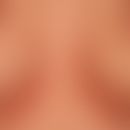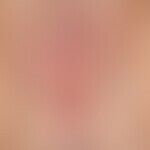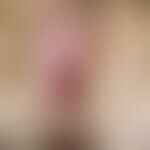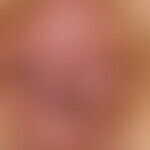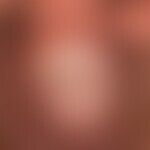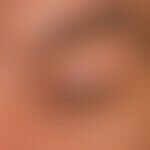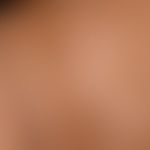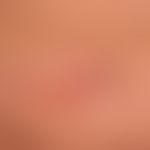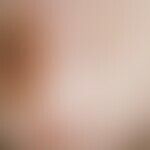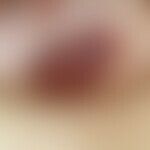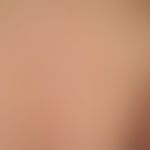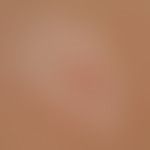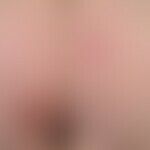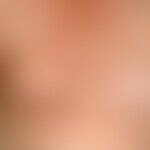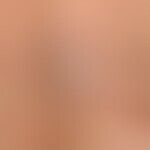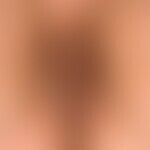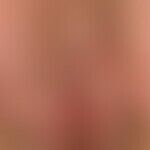Synonym(s)
HistoryThis section has been translated automatically.
DefinitionThis section has been translated automatically.
Lichen sclerosus (lichen from Greek leichen = lichen, sclerosus from Greek skleros = hard, dry, brittle) is an acquired, non-infectious, mucocutaneous, chronic inflammatory (autoimmunological) disease with a phasic course.
You might also be interested in
ClassificationThis section has been translated automatically.
Clinical-topographical the Lichen sclerosus can be classified:
- Lichen sclerosus of the penis (male)
- Lichen sclerosus of the vulva (of the woman)
- Extragenital lichen sclerosus
The different clinical processes and prognoses allow a classification into:
- Prepubertal lichen sclerosus
- Postpubertal lichen sclerosus
Occurrence/EpidemiologyThis section has been translated automatically.
Different information depending on the collective.
Prevalences of 0.1% are reported for young girls and up to 3% for adult women.
Cross-sectional analyses of larger non-preselected male US collectives showed prevalences of 1.4 - 2.1/100,000.
EtiopathogenesisThis section has been translated automatically.
It is (analogous to lichen planus) a T-cell-mediated disease (Terlou A et al. 2012)
An autoimmunological genesis is discussed; furthermore, hormonal factors, dysregulation of the sex hormones, infectious genesis(Borrelia burgdorferi; EBV infection ?), formation of autoantibodies against ECM1 (extracellular matrix protein-1 - detection in 60-70% of cases; the occurrence of these autoantibodies appears to be more of a secondary phenomenon), genetic disposition (rare familial occurrence, association with HLA-B40, HLA-B44). Specific autoantibodies are absent. Hyaluronic acid is accumulated in the lichen sclerosus lesion, associated with reduced expression of CD44 (Kaya G et al. (2000).
Evidence of associated autoimmune diseases such as (figures from a collective of 190 patients):
- autoimmunological thyroid diseases (16%)
- Vitiligo (10%)
- alopecia areata (3%)
- pernicious anemia (3%)
- primary biliary cirrhosis
An association with systemic lupus erythematosus was mentioned in several case reports.
Immunohistological similarities with circumscribed scleroderma suggest a possible pathogenetic relationship.
ManifestationThis section has been translated automatically.
Genital lichen sclerosus shows 2 age peaks:
- Prepubertal: onset in children usually between 5-11 years of age.
- Postpubertal: Adult women and men are affected in middle age (30-50 years), women preferably during the menopause; the first symptoms may appear well before the menopause (Kirtschig G 2018).
The average age is 36.6 years, the age range is 1-95 years (Conte S et al. 2025).
Large surveys show a slight predominance in women (54/46%) (Conte S et al. 2025)
LocalizationThis section has been translated automatically.
Genitoanal area: vulva, prepuce, glans penis, anal area (often genito-anal pattern in an 8-formation, this is especially detectable in prepubertal lichen sclerosus).
Extragenital (about 1-2% of cases): Mainly lateral neck area, clavicle area, pre-sternal, submammary also mammary, flexor sides of the forearms, shoulders, head and neck region; very rare is the involvement of oral mucosa (Corazza M et al. 2024).
ClinicThis section has been translated automatically.
I. Genital/genito-anal lichen sclerosus:
- Prepubertal: Typical is anogenital involvement with sharply defined, whitish plaques with a shiny surface, which often cover the vulva and anus in an 8-formation. The initial foci of lichen sclerosus usually cause no symptoms. Occasionally mild itching is reported,
- In adults, agonizing pruritus, sometimes combined with pain (rhagade formation), especially during sexual intercourse, is in the foreground.
- In the later course, whitish-atrophic, porcelain-like plaques with a marked increase in consistency and a tendency to shrink are found. Frequently bleeding rhagades with a tendency to superinfection. Furthermore, extensive, long-term persistent lesional hemorrhages, which can dominate the clinical picture and can be diagnostically irritating (sclerosis is covered by older or fresh "blood lakes"). In the late stage, varying degrees of severity of vulvar atrophy with atrophy of the small labia (small labia can disappear completely) and subsequently of the large labia, in the further late stage findings of kraurosis vulvae.
- Men (see below lichen sclerosus of the penis): Balanopreputial sclerosis with erosions and rhagades. Also extensive hemorrhages and varying degrees of severity of phimosis. Synechiae; in the late stage picture of the so-called "balanitis xerotica obliterans". The concordant development of squamous cell carcinomas is around 5% in larger collectives.
II Extragenital lichen sclerosus:
- Confetti type: Mostly disseminated or also grouped, white or gray-brown spots and plaques about 0.2-0.5 cm in size. Occurs mainly on the axillae and flexor sides of the wrists, on the trunk and on the neck. Often no mucosal involvement in this type.
- Map type: Here the initially small focal areas of lichen sclerosus are confluent patches and plaques with an atrophic parchment-like surface (often affecting the female mammae). A red border around the foci is typical (sign of underlying inflammation). Band-shaped hyperpigmentation is also found in the marginal area of lichen sclerosus. Lesional blistering is rarer. Almost pathognomonic are lesional hemorrhages, which can be found in different shades of red (light red, rich red or reddish brown) depending on the duration of the condition. The oral mucosa is very rarely affected.
- Special forms: bullous or hemorrhagic lichen sclerosus. The hemorrhagic component is caused by secondary (often traumatically induced) hemorrhages in the area of the lichen sclerosus. In this "bradytrophic" zone, blood is broken down very slowly so that the hemorrhage is detectable for several weeks.
HistologyThis section has been translated automatically.
Early stage: epithelial atrophy, orthohyperkeratosis, hypergranulosis. Subepithelial band-like arranged, epidermotropic round cell infiltrate. The density of this infiltrate may be considerable, so that a differential diagnosis must be made to differentiate it from epidermotropic cutaneous T-cell lymphomas.
Intermediate stage: Edema zone free of elastic fibers, with wide gaping blood and lymphatic vessels, which pushes itself zipper-like between the epidermis and the band-like inflammatory zone. Bullous transformation is possible.
Late stage: Increasing sclerosing tendency and regression of cellular inflammatory phenomena.
Immunohistology: Dermal infiltrate predominantly of T lymphocytes, with high percentage of B lymphocytes (20-30%).
Note: sufficiently deep punch biopsy (do not squeeze) from lesional, non-steroidal pre-treated skin/mucosa.
DiagnosisThis section has been translated automatically.
Differential diagnosisThis section has been translated automatically.
Clinical:
- Circumscribed scleroderma (guttata type): no genital or anal involvement. Plaque-like on trunk and extremities. Surface not parchment-like rippling.
- Lichen planus: uniform livid color, usually clearly palpable elevations (papule or plaque); itching.
- Lichen simplex chronicus Vidal: no mucosal involvement, marked pruritus, extragenital cutaneous lesions
- Psoriasis anogenitalis: no mucosal involvement; sharp border to healthy skin; frequent extragenital involvement.
- Vitiligo: sharp, often bizarre demarcation to healthy skin; no itching, no induration of skin, extragenital involvement!
- Candida infections: macerated, blurred areas, inguinal and anal regions usually also affected. Obesity, immobility, immune disorders, mycological evidence of the yeasts!
Histological:
- Lichen ruber: hyperorthokeratosis, pronounced hypergranulosis, no formation of a so-called barren zone.
- Acrodermatitis chronica atrophicans: rather sparse diffuse lymphocytic infiltrate; relvanter proportion of plasma cells. No subepithelial band-like arrangement.
- Mycosis fungoides: dense lymphocytic infiltrate, cell and nuclear polymorphism, eosinophilic granulocytes. No barren zone.
Complication(s)(associated diseasesThis section has been translated automatically.
Phimosis with subsequent complications; atrophy of the external genitalia, kraurosis vulvae (see also lichen sclerosus of the vulva), sexual dysfunctions in both sexes; in men: ischuria and urinary retention.
Note! Lichen sclerosus et atrophicus in the genital area leads to carcinoma development in 3-6% of cases in late adulthood. Women are more frequently affected! Melanomas, basal cell carcinomas and granular cell tumors are rarer.
General therapyThis section has been translated automatically.
It is important to define the therapy goal together with the patient. The focus is on minimizing the symptoms.
The therapeutic option to be chosen depends on the age of the patient, the localization (vulvar LS requires a different therapy than penile LS) and the severity of the disease (see below Lichen sclerosus of the vulva).
In cases of minor infestation (smaller plaques), purely local measures are preferable.
In more extensive cases of penile lichen sclerosus, an invasive procedure (circumcision) is recommended at an early stage.
External therapyThis section has been translated automatically.
Consistent external treatment is necessary, especially in the genital area, because of the excruciating itching and the progressive sclerosis.
- Glucocorticoids:
- Glucocorticoids are the therapeutic agents of first choice (for procedure in vulvar lichen sclerosus see there). Intermittent shock therapy with the use of highly potent glucocorticoids is recommended.
- Relatively good results can be achieved with intralesional glucocorticoid injections, such as triamcinolone acetonide crystal suspension (e.g. Triam 10 Lichtenstein burns less than Volon A) diluted 1:1 with local anesthetic, e.g. Scandicaine, especially in genital lesions with severe itching or pain. Injections can be used in combination with cryosurgery if necessary.
- Calcineurin inhibitors: Good clinical results with marked improvement of subjective symptoms and prolonged remissions can be obtained with topical therapy with tacrolimus (0.1% Protopic ointment) or pimecrolimus (Elidel cream 1%). Caution: inital burning sensation after application is often reported. Long-term experience is still lacking. In a transitional phase, it may be advisable to use the preparations in daily alternation with glucocorticoid externals.
- Hormones: In early stages in women, especially in younger women, therapy with estrogen- and progesterone-containing preparations (e.g. Linoladiol N cream, Cordes Estriol cream, Estriol ointment) for several weeks. Relatively good results are achieved with these products.
- In men, 2-5% testosterone ointment/gel (e.g. Androderm, R249 ) over several months often produces good results. This therapy should no longer be used for women because of the risk of virilization! Caution! Resorption! In girls this therapy is absolutely contraindicated!
- Careful external care: In case of infestation of the large or small labia, careful local care (dexpanthenol ointment R065, estrogen-containing hydrophilic creams) and meticulous intimate care. Use of a bidet after visiting the toilet, if bidet is not available, a good option would be the HappyPo Easy-Bidet (mobile hand-bottom shower). If this is not possible, first dab with damp toilet paper, then dab the lesions with oil-soaked hygienic wipes. Before sports or longer walks, apply a hydrophilic or hydrophobic ointment, e.g. Vaselin. alb. or Deumavan® ointment as a ready-to-use preparation.
- In addition, regular sitz baths with astringent agents (e.g. Tannosynt) are recommended for genital and perianal LS.
- Treatment of genital fluorosis, especially candidiasis.
- Alternative: Comparable results to calcineurin inhibitors, have been reported in an alternative approach using a thymus peptide active (Sclero Discret Thymusskin Intimate Care Cream). These results require further confirmation.
Radiation therapyThis section has been translated automatically.
Internal therapyThis section has been translated automatically.
- in case of severe infestation, treatment with methotrexate (15mg/week over a period of 6-12 months; personal experience).
- Trial with acitretin (neotigason) 0.1-0.2 mg/kg bw/day (personal experiences are rather negative)
- Alternatively penicillin 10 Mega IU/day for 10 days, 3 treatment cycles at intervals of 4 weeks (therapy successes are not very satisfying!).
- Alternatively sulfasalazine (e.g. azulfidine) 2-4 g/day.
- If necessary, therapy with chloroquine (e.g. Resochin) 250 mg/day p.o. (this therapy strategy is also not very successful according to own experience!)
Operative therapieThis section has been translated automatically.
Surgical procedures should be used if the clinical symptoms are extensive:
- Cryosurgery: Good results can be achieved with the open procedure, in the case of circumscribed lesions with closed systems (stamps). Among these, there is a continuous improvement of itching and sclerosis (especially in the genital area). This therapy can also be used in children.
- Successes with ablative lasers have been reported. The long-term results remain to be seen.
- Circumcision is recommended in the case of prepuce and/or glans penis infections. Circumcision should be attempted at an early stage, as this therapy approach achieves the best long-term results.
- In case of lichen sclerosus of the vulva, surgical therapies are indicated if synechia and fusion of the labia have occurred. Surgical correction is also necessary in cases of constriction of the orifice externum of the urethra.
Progression/forecastThis section has been translated automatically.
Quoad vitam good, quoad sanationem at first manifestation in adulthood doubtful. Chronic, possibly decades-long, intermittent course.
Irreversible atrophy of the genitals with phimosis and atrophy of the glans penis in men and so-called Kraurosis vulvae in women.
In the case of infantile lichen sclerosus, the chance of healing by puberty is > 80% (own observations!). However, in a small part of cases the changes persist (mostly in a lighter form) even in adulthood.
Note(s)This section has been translated automatically.
There is a clear association between genital lichen sclerosus and circumscribed scleroderma.
Note: Patients with genital lichen sclerosus often suffer from the "no man's land phenomenon". They find themselves on the borderline between dermatology and gynecology and do not feel that they are in good hands.
LiteratureThis section has been translated automatically.
- Böhm M et al. (2003) Successful treatment of anogenital lichen sclerosus with topical tacrolimus. Arch Dermatol 139: 922-924
- Conte S et al. (2025) Clinical presentations and complications of lichen sclerosus: A systematic review. J Dtsch Dermatol Ges 23:143-149.
- Corazza M* et al. (2024) Lack of oral involvement in a large cohort of women with vulvar lichen sclerosus - a multicenter prospective study. J Dtsch Dermatol Ges 22:1632-1637.
- Eisendle K et al. (2008) Possible role of Borrelia burgdorferi sensu lato infection in lichen sclerosus. Arch Dermatol 144: 591-598
Haefner HK et al. (2014) The impact of vulvar lichen sclerosus on sexual dysfunction. J Womens Health (Larchmt) 23:765-770
- Hallopeau FH (1887) Du lichen plan, et particulièrement de sa forme atrophique. Union médicale (Paris) 43: 729-733
Kaya G et al. (2000) Decrease in epidermal CD44 expression as a potential mechanism for abnormal hyaluronate accumulation in superficial dermis in lichen sclerosus et atrophicus. J Invest Dermatol. 2000 Dec;115(6):1054-8.
- Kirtschig G (2018) Lichen sclerosus. Dermatologist 69: 127-133
Krapf JM at al (2020). Vulvar lichen sclerosus: Current perspectives. International Journal of Women's Health 12: 11-20. doi: 10.2147/ijwh.s191200
- Kreuter A et al. (2013) Association of autoimmune diseases with lichen sclerosus in 532 male and female patients. Acta Derm Venereol 93:238-241
Lacarrubba F et al. (2015) Extragenital lichen sclerosus: clinical, dermoscopic, confocal microscopy and histologic
correlations. J Am Acad Dermatol 72 (1 Suppl): S50-52Lee H et al. (2014) Segmental vitiligo and extragenital lichen sclerosus et atrophicus simultaneously occurring on the opposite sides of the abdomen. Ann Dermatol 26:764-765
Liu Y et al. (2013) Oral lichen sclerosus et atrophicus - literature review and two clinical cases. Chin J Dent Res 16:157-160
- Lutz V et al. (2011) High frequency of general lichen sclerosus in a prospective series of 76 patients with morphea. Arch Dermatol 2011: 305
- Paolino G et al. (2013) Lichen sclerosus and the risk of malignant progression: a case series of 159 patients. G Ital Dermatol Venereol 148:673-678
Patel B et al.(2015) Extra genital lichen sclerosus et atrophicus with cutaneous distribution and morphology simulating lichen planus. Indian J Dermatol 60:105
Philippou P et al. (2013) Genital lichen sclerosus/balanitis xerotica obliterans in men with penile carcinoma: a critical analysis. BJU Int 111:970-976
Pope E et al. (2013) Diagnosis and management of morphea and lichen sclerosus and atrophicus in children. Pediatr Clin North Am 61:309-319
Schürch HG (2018) Lichen sclerosus-underdiagnosed and undertreated. hautnah Dermatologie 34: 50-56
Terlou A et al. (2012) An autoimmune phenotype in vulvar lichen sclerosus and lichen planus: a Th1
response and high levels of microRNA-155. J Invest Dermatol 132:658-666.
Incoming links (53)
Anal carcinoma; Anal fissure; Anetoderma; Autoimmune diseases; Betamethasone valerate cream hydrophilic 0.025/0.05 or 0.1% (nrf 11.37.); Betamethasone valerate emulsion hydrophilic 0,025/0,05 or 0,1 % (nrf 11.47.); Brezky's disease; Candidiasis vulvovaginale; Carrots; CD44 gene; ... Show allOutgoing links (32)
Acitretin; Acrodermatitis chronica atrophicans; Alopecia areata (overview); Aluminium chloride hexahydrate gel 15/20% (nrf 11.24.); Ammonium bituminosulfonate paste 2% (w/o); Autoantibodies; Borrelia burgdorferi sensu lato; Calcineurin inhibitors; Candidoses; CD44 gene; ... Show allDisclaimer
Please ask your physician for a reliable diagnosis. This website is only meant as a reference.
Images (48)
Articlecontent
- History
- Definition
- Classification
- Occurrence/Epidemiology
- Etiopathogenesis
- Manifestation
- Localization
- Clinic
- Histology
- Diagnosis
- Differential diagnosis
- Complication(s)(associated diseases
- General therapy
- External therapy
- Radiation therapy
- Internal therapy
- Operative therapie
- Progression/forecast
- Note(s)
- Literature
- References
- Authors
